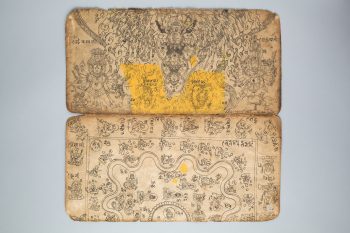Nepal
18th century


Nepal
18th century


Nepal’s Kathmandu Valley has long been a center of art making, and thus a number of objects from there that give insight into the artistic process have been preserved. Among these are sketchbooks, which were used as reference materials for painters who had to accurately reproduce complex and precise deity representations in both Hindu and Buddhist traditions.This sketchbook page depicts an assembly of nine snake deities (naga), figures that rule the water and the underground and are appealed to for both wealth and fertility. They are drawn in fine detail with accompanying annotations that indicate the colors they should be painted. The exceptional qualities of this sketchbook make it clear that it was drafted by a masterful artist. Its complex shapes of intertwined figures are confidently outlined and overlap is avoided, even in the case of the many objects the deities hold. An impressive amount of detail was included for a sketchbook composition. The water background and border have been drawn in full, and the minor figures, particularly the demons under the feet of each snake deity, are each shown in a different posture.
While the primary religious goal for followers of Buddhism is enlightenment, many of the practices also serve secular goals related to daily life, including ethical conduct and cultivating well-being.
Prescribed practices that carry symbolic meaning and value within a specific tradition and are intended to attain a desired outcome. Rituals are usually done as part of a ceremony or regular routine.
Hindu gods (deva) are thought to be manifestations of the absolute, or Brahman. The goddesses (devi) are considered manifestations of the Great Mother Goddess (Mahadevi), who is seen as the counterpart to Brahman.
The Himalayan kingdoms of the Kathmandu Valley were significant centers of Buddhist culture. Nepalese kings, Buddhist institutions, and ordinary people patronized the vibrant art guilds. The artistic traditions of the regions are well-known in Tibetan areas and beyond, and Newar artists have always been in high demand throughout Tibetan regions and Inner Asia.
Get the latest news and stories from the Rubin, plus occasional information on how to support our work.